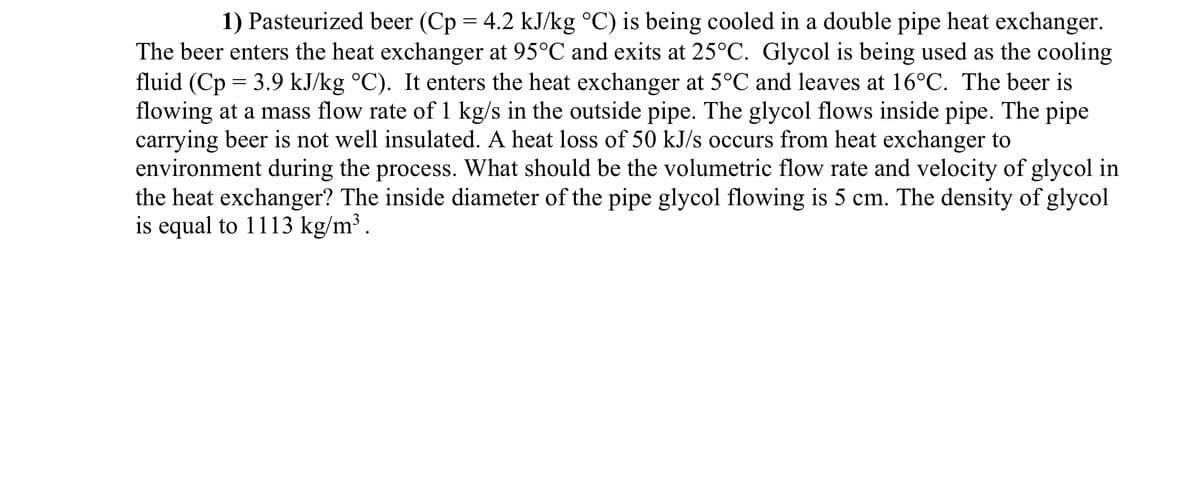1) Pasteurized beer (Cp = 4.2 kJ/kg °C) is being cooled in a double pipe heat exchanger. The beer enters the heat exchanger at 95°C and exits at 25°C. Glycol is being used as the cooling fluid (Cp = 3.9 kJ/kg °C). It enters the heat exchanger at 5°C and leaves at 16°C. The beer is flowing at a mass flow rate of 1 kg/s in the outside pipe. The glycol flows inside pipe. The pipe carrying beer is not well insulated. A heat loss of 50 kJ/s occurs from heat exchanger to environment during the process. What should be the volumetric flow rate and velocity of glycol in the heat exchanger? The inside diameter of the pipe glycol flowing is 5 cm. The density of glycol is equal to 1113 kg/m³.
1) Pasteurized beer (Cp = 4.2 kJ/kg °C) is being cooled in a double pipe heat exchanger. The beer enters the heat exchanger at 95°C and exits at 25°C. Glycol is being used as the cooling fluid (Cp = 3.9 kJ/kg °C). It enters the heat exchanger at 5°C and leaves at 16°C. The beer is flowing at a mass flow rate of 1 kg/s in the outside pipe. The glycol flows inside pipe. The pipe carrying beer is not well insulated. A heat loss of 50 kJ/s occurs from heat exchanger to environment during the process. What should be the volumetric flow rate and velocity of glycol in the heat exchanger? The inside diameter of the pipe glycol flowing is 5 cm. The density of glycol is equal to 1113 kg/m³.
Elements Of Electromagnetics
7th Edition
ISBN:9780190698614
Author:Sadiku, Matthew N. O.
Publisher:Sadiku, Matthew N. O.
ChapterMA: Math Assessment
Section: Chapter Questions
Problem 1.1MA
Related questions
Concept explainers
Heat Exchangers
Heat exchangers are the types of equipment that are primarily employed to transfer the thermal energy from one fluid to another, provided that one of the fluids should be at a higher thermal energy content than the other fluid.
Heat Exchanger
The heat exchanger is a combination of two words ''Heat'' and ''Exchanger''. It is a mechanical device that is used to exchange heat energy between two fluids.
Question
1.

Transcribed Image Text:1) Pasteurized beer (Cp = 4.2 kJ/kg °C) is being cooled in a double pipe heat exchanger.
The beer enters the heat exchanger at 95°C and exits at 25°C. Glycol is being used as the cooling
fluid (Cp = 3.9 kJ/kg °C). It enters the heat exchanger at 5°C and leaves at 16°C. The beer is
flowing at a mass flow rate of 1 kg/s in the outside pipe. The glycol flows inside pipe. The pipe
carrying beer is not well insulated. A heat loss of 50 kJ/s occurs from heat exchanger to
environment during the process. What should be the volumetric flow rate and velocity of glycol in
the heat exchanger? The inside diameter of the pipe glycol flowing is 5 cm. The density of glycol
is equal to 1113 kg/m³.
Expert Solution
This question has been solved!
Explore an expertly crafted, step-by-step solution for a thorough understanding of key concepts.
This is a popular solution!
Trending now
This is a popular solution!
Step by step
Solved in 3 steps with 3 images

Knowledge Booster
Learn more about
Need a deep-dive on the concept behind this application? Look no further. Learn more about this topic, mechanical-engineering and related others by exploring similar questions and additional content below.Recommended textbooks for you

Elements Of Electromagnetics
Mechanical Engineering
ISBN:
9780190698614
Author:
Sadiku, Matthew N. O.
Publisher:
Oxford University Press

Mechanics of Materials (10th Edition)
Mechanical Engineering
ISBN:
9780134319650
Author:
Russell C. Hibbeler
Publisher:
PEARSON

Thermodynamics: An Engineering Approach
Mechanical Engineering
ISBN:
9781259822674
Author:
Yunus A. Cengel Dr., Michael A. Boles
Publisher:
McGraw-Hill Education

Elements Of Electromagnetics
Mechanical Engineering
ISBN:
9780190698614
Author:
Sadiku, Matthew N. O.
Publisher:
Oxford University Press

Mechanics of Materials (10th Edition)
Mechanical Engineering
ISBN:
9780134319650
Author:
Russell C. Hibbeler
Publisher:
PEARSON

Thermodynamics: An Engineering Approach
Mechanical Engineering
ISBN:
9781259822674
Author:
Yunus A. Cengel Dr., Michael A. Boles
Publisher:
McGraw-Hill Education

Control Systems Engineering
Mechanical Engineering
ISBN:
9781118170519
Author:
Norman S. Nise
Publisher:
WILEY

Mechanics of Materials (MindTap Course List)
Mechanical Engineering
ISBN:
9781337093347
Author:
Barry J. Goodno, James M. Gere
Publisher:
Cengage Learning

Engineering Mechanics: Statics
Mechanical Engineering
ISBN:
9781118807330
Author:
James L. Meriam, L. G. Kraige, J. N. Bolton
Publisher:
WILEY